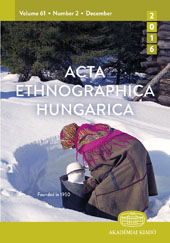The Museum of Ethnography’s Haban Ceramics in Budapest
The Museum of Ethnography’s Haban Ceramics in Budapest
Author(s): Gabriella VidaSubject(s): Archaeology, Museology & Heritage Studies, Visual Arts, Ancient World, Cultural Anthropology / Ethnology
Published by: Akadémiai Kiadó
Keywords: Late Haban; waster shard; Haban court; Habanszki Dvor; potter’s sign panel; faience technique; Nagylévárd coloured type; Nagylévárd blue and white type; provenance; faience manufactory;
Summary/Abstract: The Ceramics Collection in the Museum of Ethnography contains around 2300 faience objects, of which 60 are classical Haban vessels and at least 1500 are Late Haban pieces. There are examples of transition between Haban style periods and exceptions that make this collection unique, compared to other collections of Haban objects. The largest collection in Hungary of Late Haban objects is also found here. The study presents the most interesting pieces, how the larger groups entered the collection, and the different object groups. It describes 45 archaeological finds unearthed on the sites of three Haban settlements, that provide valuable information on the technique used to make them. Based on the ornamentations on a Haban product from 1732 we can date and identify two types from Nagylévárd (now Veľké Leváre, Slovakia): one with coloured painting and the other one with blue ornamentation on a white ground). The study calls for a debate on ceramics history to clarify questions related to both Haban and lead-glazed pottery produced in a micro-region by the German-speaking people living in the mining towns in the first half of the 18th century. Late Haban ware was popular throughout the entire territory of Hungary in the 18th to 19th centuries. Examples have been found in almost all micro-regions.
Journal: Acta Ethnographica Hungarica
- Issue Year: 60/2015
- Issue No: 2
- Page Range: 305-322
- Page Count: 18
- Language: English
- Content File-PDF

